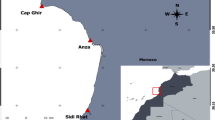Abstract
To determine the reproductive season of the giant jellyfish Nemopilema nomurai, we investigated gonadal maturity in specimens collected from the East China Sea, Korea Strait, Wakasa Bay, and the Shonai Coast of Yamagata Prefecture. After the sex of the samples was determined, the long axis of at least 256 oocytes from each female was measured. In specimens collected from the coast of Japan in 2005 and in 2006, all gonads were sufficiently developed to determine sex. However, 18 of the 20 specimens from the East China Sea collected in July 2005 were immature, and sex could not be determined. The maximum and third quartile of oocyte length had a significant correlation with days elapsed from 30 June, but they were not related to bell diameter. Observations of gonad tissue sections of specimens collected in Wakasa Bay in 2006 confirmed that oocyte length was a good proxy for female maturity. Male maturity could also be determined. In conclusion, the sex of all of the small-sized medusae collected along the coast of Japan was determinable, and their gonads were at various stages of development up to fully mature. Therefore, the occurrence of small-sized jellyfish during the autumn in Wakasa Bay is not caused by recruitment of young population from the nearby coast.







Similar content being viewed by others
References
Yan LP, Li SF, Ding FY (2004) The preliminary studies on the dynamics of macro-jellyfish resources and their relationship with fisheries in the East China Sea and Yellow Sea (in Chinese with English abstract). Mar Fish 26:9–12
Kawahara M, Uye S, Ohtsu K, Iizumi H (2006) Unusual population explosion of the giant jellyfish Nemopilema nomurai (Scyphozoa: Rhizostomeae) in East Asian waters. Mar Ecol Prog Ser 307:161–173
Yoon WD, Yang JY, Shim MB, Kang HK (2008) Physical processes influencing the occurrence of the giant jellyfish Nemopilema nomurai (Scyphozoa: Rhizostomeae) around Jeju Island, Korea. J Plankton Res 30:251–260
Uye S (2008) Blooms of the giant jellyfish Nemopilema nomurai: a threat to the fisheries sustainability of the East Asian Marginal Seas. Plankton Benthos Res 3(Suppl):125–131
Yasuda T, Toyokawa M (2008) In situ diameter measurement of Nomura’s jellyfish Nemopilema nomurai by using a newly developed tool (in Japanese with English abstract). Suisangakkaishi 74:161–165
Ohtsu M, Kawahara M, Ikeda H, Uye S (2007) Experimental induction of gonadal maturation and spawning in the giant jellyfish Nemopilema nomurai (Scyphozoa: Rhizostomeae). Mar Biol 152:667–676
Arai MN (1997) A functional biology of Scyphozoa. Chapman and Hall, London
Rottini Sandrini L, Avian M (1991) Reproduction of Pelagia noctiluca in the central and northern Adriatic Sea. Hydrobiologia 216/217:197–202
Pitt KA, Kingsford MJ (2000) Reproductive biology of the edible jellyfish Catostylus mosaicus (Rhizostomeae). Mar Biol 137:791–799
Crawley MJ (2005) Statistics: an introduction using R. John Wiley and Sons, Chichester
Ihaka R, Gentleman RR (1996) A language for data analysis and graphics. J Comput Graph Stat 5:299–314
Hamner WM, Jenssen RM (1974) Growth, degrowth, and irreversible cell differentiation in Aurelia aurita. Am Zool 14:833–849
Acknowledgments
We thank all of the fishermen of the Echizen-cho Fisheries Cooperative Association, the Wakasa-Mikata Fisheries Cooperative Association, the Hiruga Fisheries Cooperative Association, the Niu Fisheries Cooperative Association, the Nohara Large Set-net Association, and the Nisaburo Co. Ltd. who kindly accepted our research and provided a lot of support. We also thank Mr. K. Okuizumi of Kamo Aquarium, Messrs. N. Sobajima and Y. Ueno of the Kyoto Institute of Oceanic and Fishery Science, Mr. H. Morita of the National Research Institute of Fisheries Science, and the captain and crews of the R/V “Yoko-Maru” of the Seikai National Fisheries Research Institute, Fisheries Research Agency for help with sampling. Thanks are extended to Dr. C. Norman of Japan Scientific Texts for rewriting the English and providing useful advice. This research was funded by a research project for utilizing advanced technologies in agriculture, forestry and fisheries from the Agriculture, Forestry and Fisheries Research Council and by a research project for the international cooperative survey at the origin of giant jellyfish from the Fisheries Agency from 2006 through 2008 and from 2009 through 2011.
Author information
Authors and Affiliations
Corresponding author
Rights and permissions
About this article
Cite this article
Toyokawa, M., Shimizu, A., Sugimoto, K. et al. Seasonal changes in oocyte size and maturity of the giant jellyfish, Nemopilema nomurai . Fish Sci 76, 55–62 (2010). https://doi.org/10.1007/s12562-009-0187-9
Received:
Accepted:
Published:
Issue Date:
DOI: https://doi.org/10.1007/s12562-009-0187-9




